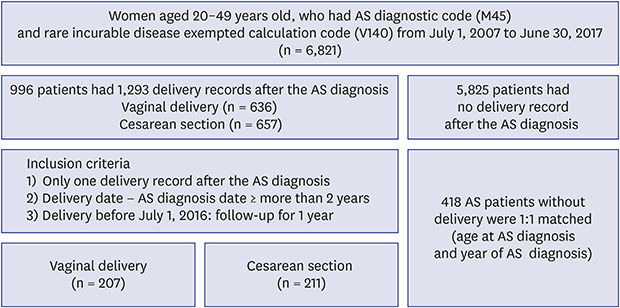1. Bergström C, Persson M, Mogren I. Pregnancy-related low back pain and pelvic girdle pain approximately 14 months after pregnancy - pain status, self-rated health and family situation. BMC Pregnancy Childbirth. 2014; 14:48.

2. Lui NL, Haroon N, Carty A, Shen H, Cook RJ, Shanmugarajah S, et al. Effect of pregnancy on ankylosing spondylitis: a case-control study. J Rheumatol. 2011; 38(11):2442–2444.

3. Ostensen M. The effect of pregnancy on ankylosing spondylitis, psoriatic arthritis, and juvenile rheumatoid arthritis. Am J Reprod Immunol. 1992; 28(3-4):235–237.

4. Ostensen M, Husby G. Ankylosing spondylitis and pregnancy. Rheum Dis Clin North Am. 1989; 15(2):241–254.
5. Østensen M, Romberg O, Husby G. Ankylosing spondylitis and motherhood. Arthritis Rheum. 1982; 25(2):140–143.

6. Ursin K, Lydersen S, Skomsvoll JF, Wallenius M. Disease activity during and after pregnancy in women with axial spondyloarthritis: a prospective multicentre study. Rheumatology (Oxford). 2018; 57(6):1064–1071.

7. Jakobsson GL, Stephansson O, Askling J, Jacobsson LT. Pregnancy outcomes in patients with ankylosing spondylitis: a nationwide register study. Ann Rheum Dis. 2016; 75(10):1838–1842.

8. Ostensen M, Ostensen H. Ankylosing spondylitis--the female aspect. J Rheumatol. 1998; 25(1):120–124.
10. Kim JA, Yoon S, Kim LY, Kim DS. Towards actualizing the value potential of Korea health insurance review and assessment (HIRA) data as a resource for health research: strengths, limitations, applications, and strategies for optimal use of HIRA data. J Korean Med Sci. 2017; 32(5):718–728.

11. van der Linden S, Valkenburg HA, Cats A. Evaluation of diagnostic criteria for ankylosing spondylitis. A proposal for modification of the New York criteria. Arthritis Rheum. 1984; 27(4):361–368.
12. Zhang J, Xie F, Delzell E, Yun H, Lewis JD, Haynes K, et al. Impact of biologic agents with and without concomitant methotrexate and at reduced doses in older rheumatoid arthritis patients. Arthritis Care Res (Hoboken). 2015; 67(5):624–632.

13. Østensen M, Husby G. A prospective clinical study of the effect of pregnancy on rheumatoid arthritis and ankylosing spondylitis. Arthritis Rheum. 1983; 26(9):1155–1159.
14. Østensen M, Fuhrer L, Mathieu R, Seitz M, Villiger PM. A prospective study of pregnant patients with rheumatoid arthritis and ankylosing spondylitis using validated clinical instruments. Ann Rheum Dis. 2004; 63(10):1212–1217.
15. Timur H, Tokmak A, Türkmen GG, Ali İnal H, Uygur D, Danışman N. Pregnancy outcome in patients with ankylosing spondylitis. J Matern Fetal Neonatal Med. 2016; 29(15):2470–2474.

16. van der Heijde D, Ramiro S, Landewé R, Baraliakos X, Van den Bosch F, Sepriano A, et al. 2016 update of the ASAS-EULAR management recommendations for axial spondyloarthritis. Ann Rheum Dis. 2017; 76(6):978–991.
17. Chung SH, Seol HJ, Choi YS, Oh SY, Kim A, Bae CW. Changes in the cesarean section rate in Korea (1982–2012) and a review of the associated factors. J Korean Med Sci. 2014; 29(10):1341–1352.

18. Feldtkeller E, Lind-Albrecht G, Rudwaleit M. Core set of recommendations for patients with ankylosing spondylitis concerning behaviour and environmental adaptations. Rheumatol Int. 2013; 33(9):2343–2349.

19. Kwak MY, Lee SM, Lee TH, Eun SJ, Lee JY, Kim Y. Accessibility of prenatal care can affect inequitable health outcomes of pregnant women living in obstetric care underserved areas: a nationwide Population-based study. J Korean Med Sci. 2019; 34(1):e8.








 PDF
PDF Citation
Citation Print
Print






 XML Download
XML Download